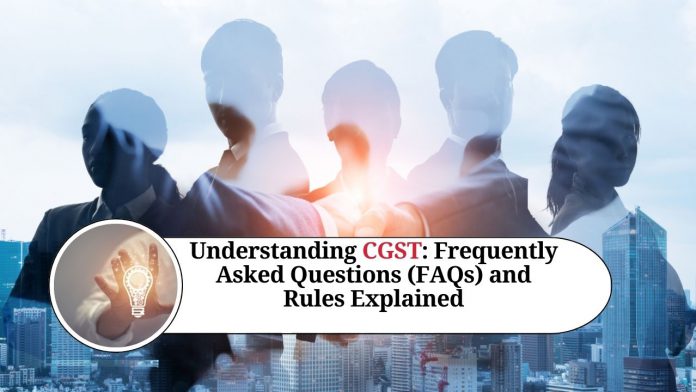Goods and Services Tax (GST) is an indirect tax levied on the supply of goods and services in India. The GST regime has replaced the previous tax regime of multiple indirect taxes like VAT, excise duty, service tax, etc. One of the components of GST is the Central GST (CGST), which is levied by the central government on intra-state supplies of goods and services.
To understand CGST rules, it is essential to know that GST is a destination-based tax. This means that the tax is levied at the place where the final consumption of goods or services takes place. CGST is one of the three components of GST, the other two being State GST (SGST) and Integrated GST (IGST).
Under CGST rules, every registered person is required to pay tax on the value of goods and services supplied by them. The tax rate for CGST is determined by the GST Council, which is a body of central and state government representatives. The current rate of CGST is 9%, and it applies to most goods and services.
The following are some of the important CGST rules that every taxpayer should be aware of:
- Registration: Every person who is engaged in the supply of goods or services and has an annual turnover of more than Rs. 20 lakhs (Rs. 10 lakhs for special category states) is required to register for GST. Registration can be done online on the GST portal.
- Tax payment: CGST is to be paid on a monthly or quarterly basis, depending on the turnover of the taxpayer. The tax payment can be made online through the GST portal.
- Input tax credit: The input tax credit (ITC) is the tax paid on inputs used for the production of goods or services. Under CGST rules, a registered person can claim ITC on the tax paid on inputs used in the course of business.
- Invoicing: Under CGST rules, every registered person is required to issue a tax invoice for the supply of goods or services. The tax invoice should contain details like the name and address of the supplier and recipient, the GSTIN of both parties, a description of goods or services supplied, the value of goods or services supplied, and the amount of tax charged.
- Returns: Every registered person is required to file monthly or quarterly returns, depending on their turnover. The return should contain details of all the supplies made, tax paid, and ITC claimed.
- Composition scheme: Under the composition scheme, small taxpayers with an annual turnover of up to Rs. 1.5 crores can pay tax at a lower rate and are required to file quarterly returns instead of monthly returns. However, businesses availing of the composition scheme cannot claim ITC and are required to issue a bill of supply instead of a tax invoice.
- Tax liability: The liability to pay CGST arises when there is a supply of goods or services. The tax is payable on the transaction value of goods or services supplied, which is the actual consideration received for the supply. In case of any discounts or other deductions from the price, the transaction value is adjusted accordingly.
- Time of supply: The time of supply is the point in time when the liability to pay tax arises. Under CGST rules, the time of supply for goods is the date of delivery or the date on which the goods are made available to the recipient, whichever is earlier. For services, the time of supply is the date of issue of invoice or receipt of payment, whichever is earlier.
- Place of supply: The place of supply determines whether a transaction is an intra-state supply or an inter-state supply. In the case of an intra-state supply, CGST and SGST are levied, whereas, in the case of an inter-state supply, IGST is levied. The place of supply for goods and services is determined based on various factors like the location of the supplier, the place of delivery, and the nature of the transaction.
- Auditing and assessment: Under the CGST rules, the tax authorities have the power to conduct audits and assessments to verify the compliance of taxpayers. They can examine the books of accounts, records, and other documents of the taxpayer to ensure that the tax has been paid correctly.
Final Conclusion
In summary, CGST is a critical component of the GST regime in India. Taxpayers need to understand the various rules and regulations governing CGST to comply with the law and avoid any penalties or legal issues. The government has made significant efforts to simplify the GST law, and taxpayers must stay updated with the latest developments in the GST regime.
Read more useful content:
Here are some frequently asked questions (FAQs) about CGST:
- What is CGST?
CGST stands for Central Goods and Services Tax, which is levied by the central government on intra-state supplies of goods and services. It is one of the three components of GST, the other two being State Goods and Services Tax (SGST) and Integrated Goods and Services Tax (IGST).
- Who is liable to pay CGST?
Every registered person is liable to pay CGST on the supply of goods or services made by them. The liability to pay CGST arises when there is a supply of goods or services, and the tax rate is determined by the GST Council.
- What is the tax rate for CGST?
The current tax rate for CGST is 9%. However, the GST Council has the power to revise the tax rate from time to time.
- How is CGST different from SGST and IGST?
CGST is levied by the central government on intra-state supplies of goods and services, whereas SGST is levied by the state government on intra-state supplies of goods and services. IGST is levied on inter-state supplies of goods and services.
- What is the input tax credit under CGST?
Input tax credit (ITC) is the credit that a registered person can claim on the tax paid on inputs used for the production of goods or services. Under CGST rules, a registered person can claim ITC on the tax paid on inputs used in the course of business.
- What is the time of supply under CGST?
The time of supply is the point in time when the liability to pay tax arises. Under CGST rules, the time of supply for goods is the date of delivery or the date on which the goods are made available to the recipient, whichever is earlier. For services, the time of supply is the date of issue of invoice or receipt of payment, whichever is earlier.
- What is the place of supply under CGST?
The place of supply determines whether a transaction is an intra-state supply or an inter-state supply. In the case of an intra-state supply, CGST and SGST are levied, whereas, in the case of an inter-state supply, IGST is levied. The place of supply for goods and services is determined based on various factors like the location of the supplier, the place of delivery, and the nature of the transaction.
- What is the composition scheme under CGST?
The composition scheme is a scheme under which small taxpayers with an annual turnover of up to Rs. 1.5 crores can pay tax at a lower rate and are required to file quarterly returns instead of monthly returns. However, businesses availing of the composition scheme cannot claim ITC and are required to issue a bill of supply instead of a tax invoice.
- What are the penalties for non-compliance with CGST rules?
Penalties for non-compliance with CGST rules can include interest, fines, and even imprisonment in some cases. Taxpayers need to comply with the CGST rules to avoid any penalties or legal issues.
- How can I register for CGST?
You can register for CGST online on the GST portal. You will need to provide your business details, bank account details, and other relevant information to complete the registration process.




















